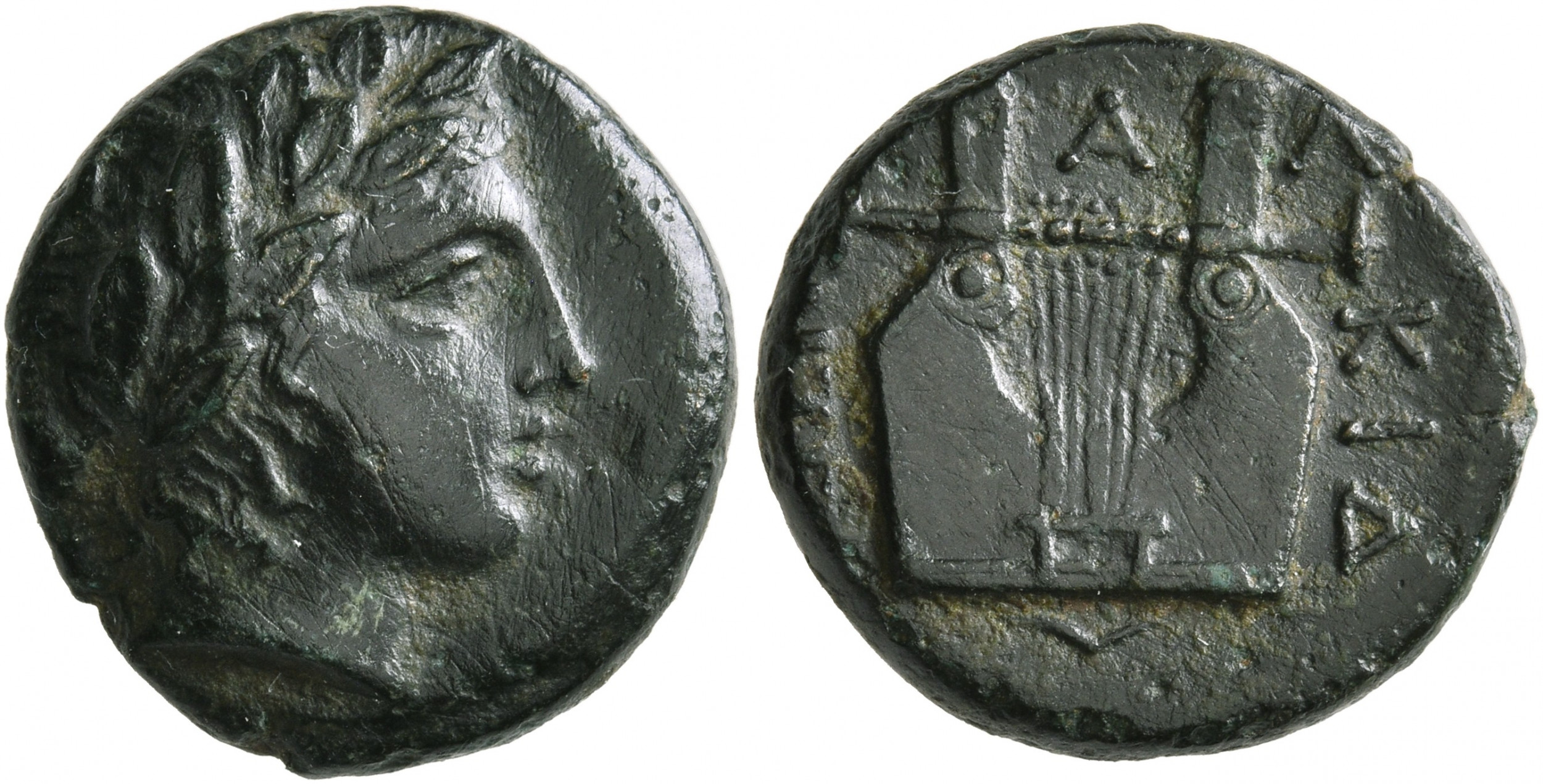Olynthus (Chalcidian League), bronze, ca 3.50g (Apollo/cithara) (400-348 BCE)
From SILVER
(Redirected from AC 158 - Olynthus (Chalcidian League), bronze, module A (400-348 BCE))
400 BCE - 348 BCE Bronze
Description
| ObverseInscription or printing placed on the obverse.: | Head of Apollo left or right, wearing laurel wreath. |
| ReverseInscription or printing placed on the reverse.: | X-A-Λ-KIΔ-ΕΩΝ (Greek).Kithara |
Mint and issuing power
| MintIdentifies the place of manufacture or issue of a numismatic object.: | Olynthus | Ancient regionAncient region.: | Macedon | Modern countryModern country: Greece | AuthorityIdentifies the issuing power. The authority can be "pretended" when the name or the portrait of X is on the coin but he/she was not the issuing power. It can also be "uncertain" when there is no mention of X on the coin but he/she was the issuing power according to the historical sources: | Chalcidian League (c. 430-348 BC) |
Chronology
| FromIdentifies the initial date in a range assigned in a numismatic context. | 400 BCE | toIdentifies the final date in a range assigned in a numismatic context.. | 348 BCE | PeriodTime period of the numismatic object.: Classical 480-323 BC |
Physical description
| MetalThe physical material (usually metal) from which an object is made.: | Bronze |
Median weightMedian of the weights of numismatic objects (in grams). in grams | 3.50 | DenominationTerm indicating the value of a numismatic object. Examples: tetradrachm, chalkous, denarius.: | Module A | StandardStandard.: |
Image

AC158 Olynthus.jpeg [1]
References
| Die study referencePublication of the study: | Psoma 20011Psoma 2001, p. 19-54 (n° 1-398 du catalogue) | ||
| Coin series referenceReference to coin series study: | HGC 3.12HGC 3.1, n° 511, RQEMAC3RQEMAC, n° 158 | ||
| Coin series web referenceCoin series web references: | |||
Obverse dies distribution
Reverse dies distribution
no distribution is available
Quantification
| Number of obversesNumber of obverse dies. ᵖ (o) | 282 | Number of singletons (o1)The number of singleton coins. ᵖ | 130 |
| Number of reverse diesNumber of reverse dies. (r) | 329 | Number of coinsNumber of coins. (n) | 598 |
| Coins per obverse dieNumber of coins per obverse die. (n/o) | 2.12 | Coins per reverse dieNumber of coins per reverse die. (n/r) | 1.82 |
| Reverse per obverse ratioRatio of obverse dies divided by reverse dies. (r/o) | 1.17 | Percentage of singletons (o1)number of coins (n) divided by the number of singletons (o1) ᵖ | 46.1 % |
| Original number of dies (O) (Carter 1983 formula)The estimation of the number of coins according to Carter 1983 ᵖ | 437.29 | Coins struck if 20,000 as average productivity per dieCoins made if the average productivity for obverses (according to Carter) is 20,000. ᵖ | 8,745,800 |
| Original number of dies (O) (Esty 2011 formula)The estimation of the number of coins according to the singleton formula in Esty 2011 ᵖ (O) | 533.66 | Survival rate if 20,000 as average productivity per dieSurvival rate if average productivity is 20,000. ᵖ | 0.00007 |
| Coverage (o = % of O) (Esty 1984 formula)Esty 1984 - coverage (% of O) ᵖ (o = % of O) | 78.26% | Die productivity if survival rate 1/2,000Average productivity if survival rate is 1/2,000. ᵖ | 2,735.03 |
| Weight of silver (in kg) if 20,000 coins per die (O = Carter formula)Carter 1983 * Median weight * 20000 (*10 if gold or electrum) ᵖ | n.a. | Die productivity if survival rate 1/5,000Average productivity if survival rate is 1/5,000. ᵖ | 6,837.57 |
Remarks
References
- ^ Selene, Psoma (2001), Olynthe et les Chalcidiens de Thrace, Etude de numismatique et d’histoire, Stuttgart, 310 p.
- ^ Hoover, Oliver D. (2016), Handbook of coins of Macedon and its neighbors. 3. Part I: Macedon, Illyria, and Epeiros, sixth to first centuries BC, Lancaster, 437 p.
- ^ Callataÿ, François de (2003), Recueil quantitatif des émissions monétaires archaïques et classiques, Numismatique Romaine, Wetteren, VII + 267 p.